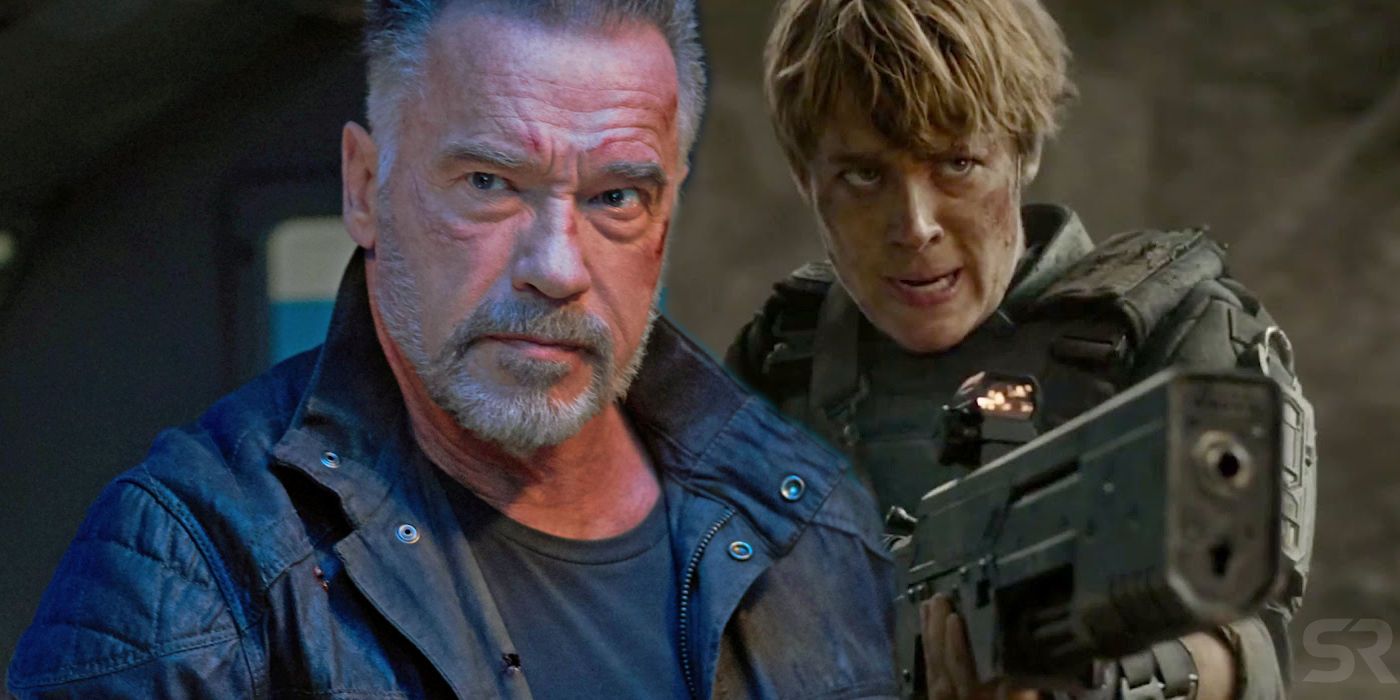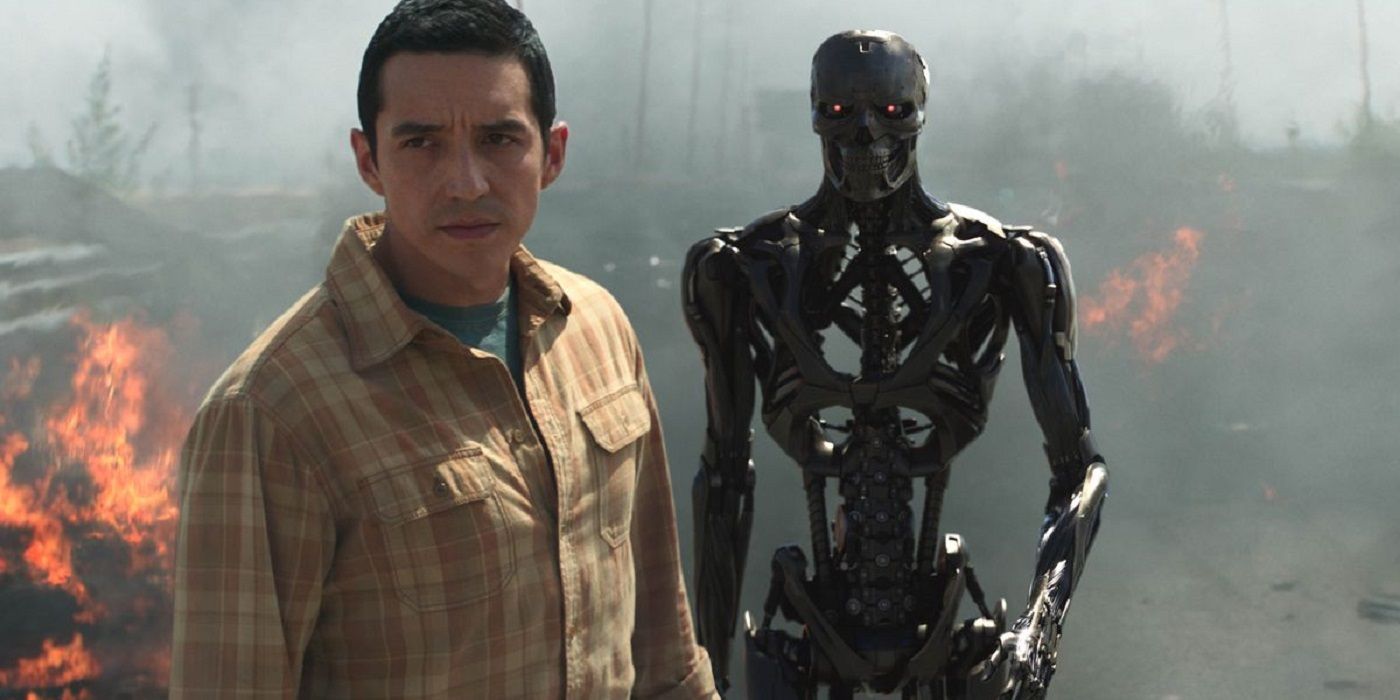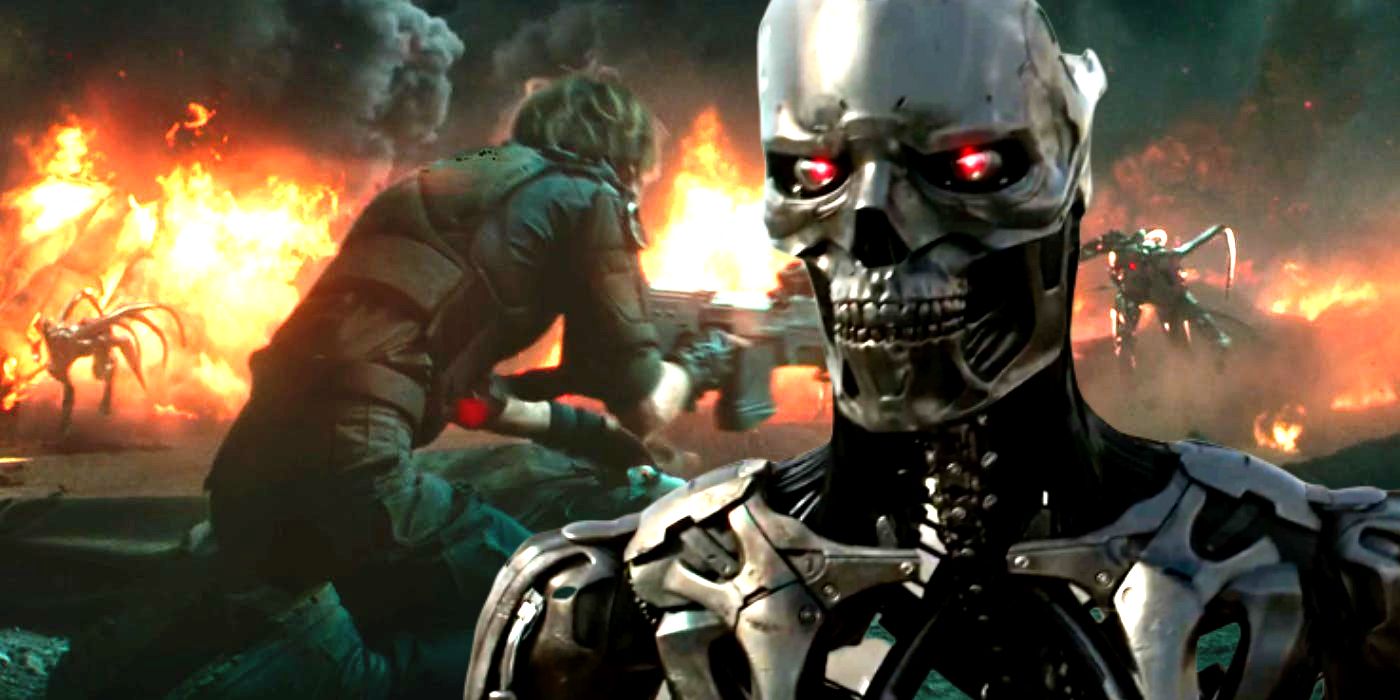Time travel in Terminator: Dark Fate slightly differs from the established logic from the original two films, The Terminator and Terminator 2: Judgment Day, in addition to trying to keep everything contained in canon. Terminator: Dark Fate ignores the events from the third movie onward, thus replacing Terminator 3: Rise of the Machines as the third installment in the timeline. However, the treatment of time travel in the film allows for some odd, new discrepancies to appear.
Terminator: Dark Fate is the sixth installment in the Terminator franchise and brings back two of its biggest stars, Arnold Schwarzenegger and Linda Hamilton, plus its original creator James Cameron, for a long-awaited reunion. The film kicks off with a digitally de-aged Sarah Connor (Linda Hamilton) and John Connor (Aaron Kunitz and Edward Furlong) in 1998, moments before a third T-800 (Arnold Schwarzenegger) sent by new cybertech corporation Legion assassinates John in front of her. Devastated, Sarah spends the next 22 years preventing new Terminators from causing any carnage in the present day, thanks to mysterious coordinates sent by the same T-800 that killed John and later adopted a human personality named Carl. When Grace (Mackenzie Davis), an enhanced human sent from 2042, arrives in the present day with the mission to save the new future resistance leader, Dani Ramos (Natalia Reyes), the existence of a new, future Terminator timeline is all but confirmed.
The Terminator series is known for its influential use of science fiction elements like the uprising of artificial intelligence, a post-apocalyptic society in the wake of a nuclear war, and killer robots with eclectic abilities. One of the most memorable aspects of the franchise is the various iterations of the T-800 cyborg, which come from the dystopian future to either kill or save Sarah and John. For better or worse, the element that puts everything in motion - and simultaneously ends it - is time travel. Terminator: Dark Fate, however, presents significant differences to how time travel works within the current timeline.
Destiny Is No Longer Predetermined In Terminator
In a deleted scene from the 1984 Terminator film, Kyle Reese (Michael Biehn) delivers one of the most famous lines in the franchise to refer to the nature of time: "The future is not set. There is no fate but what we make", something that will later be repeated multiple times by different characters and reinforce the objectives of the heroes. They're always trying to evade their imminent fate, but despite their apparent victories, Skynet always ends up emerging in the future.
Several events in the first two movies accentuate the concept of predetermination, like the photo of Sarah that Reese falls in love with, passed on by future John and later revealed to have been taken by Sarah after Reese talked to her about it. Loops like these seem unbreakable until Terminator: Dark Fate introduces the abrupt death of a teenage John and the existence of a new evil entity, along with a brand new future leader to fight it. This means that John never grew up to even meet Reese and send him back in time to be with Sarah and ensure his own birth.
Terminator: Dark Fate confirms that moments that were supposed to be locked down in a loop don't exist anymore, and thus the future can be heavily modified. The aversion of Judgment Day in Terminator 2 succeeded since Skynet was eradicated. While that is true, the character who makes it all happen is subsequently terminated, causing a domino effect that brings a drastic change to various points in the timeline, as seen in the latest sequel.
Terminator: Dark Fate Rewrites Events Instead Of Replacing Them
The unexpected appearance of Legion, Grace, Dani, and the newest model of Terminator - the Rev-9 (Gabriel Luna) - means that the Connors' victory in the past still fails to prevent another tragic version of the future. The major events in the Terminator franchise still happen, although in a different way. The world is still destined to fall into chaos, a tech corporation will still rebel against humanity, and a leader of the resistance still needs to survive in the present day in order to defeat it in the future. The difference now is that none of them match what had been set up in the previous two Terminator films.
But there's another layer to it. At many points in Terminator: Dark Fate, the characters throw various callbacks to previous Terminator films, including those that Dark Fate chooses to ignore. For instance, Grace tells Dani, "Come with me or you're dead meat in 30 seconds" when she meets her, right after shooting the evil liquid Terminator (in disguise) with a shotgun instants before it gets to kill her. This is a reference to the famous "Come with me if you want to live" line from previous movies, and almost a carbon copy of the famous scene in T2 with the T-1000 (Robert Patrick) in the same situation. Similarly, she delivers her own version of the "no fate but what we make" speech, despite never meeting Kyle Reese.
Rather than a simple homage to the previous movies, this can also be understood as some sort of ripple in time - a side effect of what multiple time trips can do to the space-time continuum. The characters react to the circumstances they find themselves in, but their journeys keep following the template of the events that need to happen one way or another. Their free will is then debatable since they keep replicating actions from a past they didn't experience.
Terminator: Dark Fate Introduces Multiple Timelines In Canon
The unknown number of Terminators that are sent by Skynet before its demise may cause diverse timelines to branch out. The fall of Skynet and the subsequent rise of Legion, despite the existence of a John Connor who did actually grow up to send Kyle Reese back to 1984 to start the loop, suggests that time can be something different than a strictly predetermined cycle. In fact, some version of John Connor also had to survive to send a hacked T-800 to fight the T-1000 and fulfill the story of Terminator 2, which ends shortly before Dark Fate begins.
Then, it's possible that all of that wasn't erased, but actually happened in another timeline. This opens the possibility for the other movies that Terminator: Dark Fate ignores, such as Rise of the Machines, Terminator: Salvation, and the poorly-received Terminator: Genysis to exist in a real, yet remote, timeline. They can be seen as scenarios in which a Terminator was sent and failed, or where John Connor defeated them but also ultimately failed to prevent Judgment Day. The moment Terminator: Dark Fate breaks the cycle, every wild alternative has a chance at being real.
In retrospect, this can also apply to the first Terminator film. There may have been an alternate timeline in which nobody was sent from the future. Sarah conceived John from a different father and both of them spent their lives oblivious to the rise of Skynet. When the machines attacked and the world fell into chaos, John sent Kyle Reese back and created a timeline consisting of the seemingly unbreakable loop that governed the first two films.
-
The future is stubborn in the Terminator franchise. However it chooses to do so, Judgment Day still comes. Otherwise, no one would keep traveling back to prevent it. The fall of the mighty Skynet and the rise of its unforeseen replacement proves that the most certain thing when it comes to time travel is that the main event needs to happen one way or another. Destiny is fixed, but the road that leads to it isn't.




